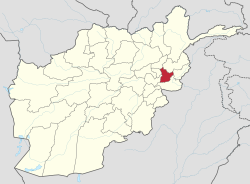Provinsi Laghman
Laghman (Pashto/Persia: لغمان) adalah sebuah provinsi dari negara Afganistan yang berada di sisi timur negara tersebut. Jumlah penduduk yang tinggal di provinsi ini sejumlah 445.600,[1] yang merupakan multi-etnis dan mayoritas merupakan wilayah perdesaan. Kota Mihtarlam merupakan ibu kota dari provinsi ini. Sejumlah dokumen sejarah menuliskan provinsi ini sebagai "Lamghan" atau sebagai "Lamghanat".
Laghman
لغمان | |
|---|---|
 Tanaman hijau yang berdiri subur sangat kontras dengan gurun di sekitarnya di Provinsi Laghman | |
 Peta Afganistan di mana Laghman diberi tanda | |
| Koordinat (Ibu kota): 34°40′N 70°12′E / 34.66°N 70.20°E | |
| Negara | |
| Ibu kota | Mihtarlam |
| Pemerintahan | |
| • Gubernur | Muhammad Asif Nang |
| Luas | |
| • Total | 3.842,6 km2 (14,836 sq mi) |
| Populasi (2015)[1] | |
| • Total | 445.588 |
| • Kepadatan | 12/km2 (30/sq mi) |
| Zona waktu | UTC+4:30 |
| Kode ISO 3166 | AF-LAG |
| Bahasa utama | |
Sejarah
Di Museum Kabul saat ini terdapat sebuah prasasti Aram yang ditemukan di Laghman yang menunjukkan rute perdagangan kuno dari India ke Palmyra.[2] Bahasa Aram adalah bahasa tertulis terkait pemerintahan di Achaemenid yang pengaruhnya meluas ke Laghman.[3] Selama invasi yang dilancarkan oleh Aleksander Agung, daerah itu dikenal sebagai Lampaka.[4]
Inscriptions in Aramaic dating from the Mauryan Dynasty were found in Laghman which discussed the conversion of Ashoka to Buddhism.[5] The inscription mentions that the distance to Palmyra is 300 dhanusha or yojana.
The Mahamayuri Tantra dated to between 1-3rd century mentions a number of popular Yaksha shrines. It mentions Yaksh Kalahapriya being worshipped in Lampaka.[6]
Healthcare
The percentage of households with clean drinking water fell from 39% in 2005 to 34% in 2011.[7] The percentage of births attended to by a skilled birth attendant increased from 3% in 2005 to 36% in 2011.[7]
Education
The overall literacy rate (6+ years of age) increased from 14% in 2005 to 26% in 2011.[7] The overall net enrolment rate (6–13 years of age) increased from 48% in 2005 to 52% in 2011.[7]
Demography
The total population of the province is about 424,100, which is multi-ethnic and mostly a rural society.[1] According to the Naval Postgraduate School, as of 2010 the ethnic groups of the province are as follows: 51.3% Pashtun, 21.7% Tajik, 27% Pashai and Nuristani (Kata).[8][9] The people of Laghman are overwhelmingly Sunni Muslim.
Referensi
- ^ a b c "Settled Population of Laghman province by Civil Division, Urban, Rural and Sex-2012-13" (PDF). Islamic Republic of Afghanistan, Central Statistics Organization. Diakses tanggal 2013-06-17.
- ^ Rahel, Shafie. "Cultural policy in Afghanistan; Studies and documents on cultural policies; 1975" (PDF). UNESCO.
- ^ "AŚOKA, Mauryan emperor of India". iranicaonline.org.
- ^ Henning, W. B. (2 April 2018). "The Aramaic Inscription of Asoka Found in Lampāka". Bulletin of the School of Oriental and African Studies, University of London. 13 (1): 80–88. JSTOR 609063.
- ^ Kurt A. Behrend. Handbuch Der Orientalistik: India. The Buddhist Architecture of Gandhara, Part 2, Volume 1. hlm. 39.
- ^ THE MAHAMAYURI VIDYARAJNI SUTRA 佛母大孔雀明王經, Translated into English by Cheng Yew Chung based on Amoghavajra’s Chinese Translation (Taisho Volume 19, Number 982)
- ^ a b c d Archive, Civil Military Fusion Centre Diarsipkan 2014-05-31 di Wayback Machine.
- ^ "Welcome - Naval Postgraduate School" (PDF). www.nps.edu. Diakses tanggal 2 April 2018.
- ^ "Laghman Province". Program for Culture & Conflict Studies. Naval Postgraduate School. Diakses tanggal 2013-06-16.
Templat:Provinces of Afghanistan Templat:Districts of Laghman